Road freight transport by journey characteristics
Data extracted in August 2024.
Planned article update: 10 September 2025.
Highlights
The EU registered an average annual growth rate of 0.6% in total road freight transport performance over the period 2019-2023.
In 2023, Poland continued to be the country with the biggest share of total EU international transport performance (64.3%).
One fifth (21.8%) of the total distances travelled by road freight vehicles in the EU was performed by empty vehicles in 2023.

(tonnes)
Source: Eurostat (road_go_ta_tott)
This article presents road freight transport in the European Union (EU) focusing on journeys performed by road freight vehicles. The article presents the different types of transport operations performed. It also discusses the average loads carried and average distances over which goods were moved, road freight transport by distance class and the transport performed by empty vehicles.
This article and the articles 'Road freight transport by vehicle characteristics', 'Road freight transport by type of goods', 'Road freight transport statistics' and 'Road freight transport statistics - cabotage' present a complete overview of road freight transport in Europe.
Full article
Road freight transport performance by type of operation (in tonne-kilometres)
In 2023, total European road freight transport performance decreased by 3.2% compared with 2022 (from 1 918.7 billion tonne-kilometres (tkm)) to 1 857.0 billion tkm). The average annual growth rate from 2019 to 2023 was 0.6% (see Table 1). The total transport decreased by 0.8% in 2020 and 0.1% in 2022, respectively, compared each time with the previous year. In 2021 it increased by 6.7% compared with the previous year.
Over the period 2019-2023, 11 of the 26 EU countries for which data are provided (Malta is exempt, see the chapter ‘Data sources’ below) reported a positive average annual growth rate in road freight transport performance, measured in tonne-kilometres (see Table 1). The largest positive average annual growth rates were observed in Czechia (+13.5%), Bulgaria (+12.6%) and Lithuania (+4.4%), while the highest negative rates were reported by Slovakia (-6.1%), Portugal (-3.6%) and Estonia (-3.3%).
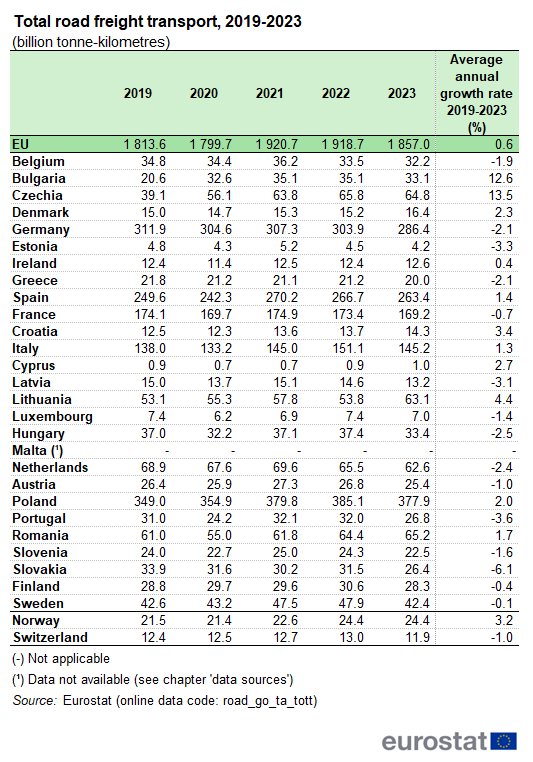
(billion tonne-kilometres)
Source: Eurostat (road_go_ta_tott)
When looking at the evolution of EU road freight transport from 2019 onwards, the trends observed for national road freight transport and international road freight transport by loaded vehicles, presented as an index (2019 = 100) based on tonne-kilometres, are very similar to each other (see Figure 1). Despite the comparable trends, international transport showed higher growth than national transport over the period. Between 2022 and 2023, national and international road freight transport by loaded vehicles decreased by 3.5 and 3.2 index points, respectively.

(based on tonne-kilometres, 2019=100)
Source: Eurostat (road_go_ta_tott)
Table 2 shows that the total national road freight transport in the EU accounted for around 1 138 billion tkm in 2023, 3.4% less than in 2022. The average annual growth rate from 2019 to 2023 was 0.4%. Most EU countries recorded positive average annual growth rates over the period 2019-2023 (15 out of 26). The highest positive rates were recorded in Bulgaria (+14.8%), followed by Slovenia (+7.7%), Romania (+7.5%) and Cyprus (+5.7%). In contrast, the largest negative rates were reported by Luxembourg (-8.1%), Portugal (-7.5%), Greece (-4.0%) and Slovakia (-3.1%).

(billion tonne-kilometres)
Source: Eurostat (road_go_ta_tott)
At EU level, international road freight transport in 2023 decreased by 3.0% compared with 2022, from 742 billion tkm to 719 billion tkm. The average annual growth rate was 0.9% between 2019 and 2023 (see Table 3). A third of EU countries (9 out of 26) recorded increases over this period, some of them considerable: Czechia recorded an average annual growth rate of 26.8%, followed by Bulgaria with a rate of 11.9% and Lithuania with 4.4%. At the other end of the scale, among the 16 EU countries for which international transport fell, Slovakia had the highest negative average annual growth rate (-6.9%), followed by Latvia (-5.9%), Belgium and Hungary (-4.9% each). There was no change between 2019 and 2023 for Cyprus, which had only negligible international road freight transport.
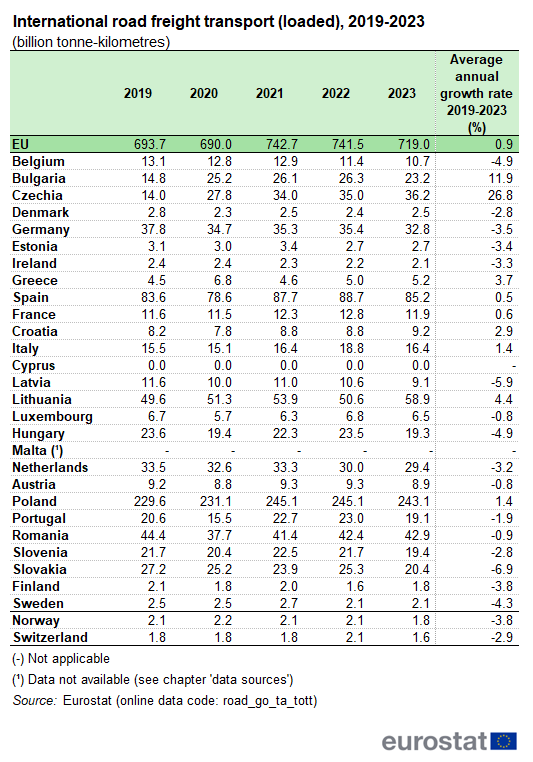
(billion tonne-kilometres)
Source: Eurostat (road_go_ta_tott)
The share of international transport in the total road freight transport of a country varies considerably (see Figure 2). The highest shares of international transport were registered in Lithuania in both 2022 and 2023 (94.1% and 93.4%, respectively), followed by Luxembourg (92.0% in 2022 and 92.9% in 2023) and Slovenia (89.4% in 2022 and 86.3% in 2023). In contrast, the lowest shares were registered in Cyprus (2.7% in 2022 and 3.6% in 2023), Sweden (4.4% in 2022 and 5.0% in 2023) and Finland (5.1% in 2022 and 6.2% in 2023).

(% share of total, based on tonne-kilometres)
Source: Eurostat (road_go_ta_tott)
When looking at the shares of the individual EU countries in the total EU international road freight transport in 2023 (see Figure 3), Poland continued to have the highest share in total tonne-kilometres with 33.8%. International transport made up 63.6% of total road freight transport in tonne-kilometres in Poland in 2022, increasing to 64.3% in 2023 (see Figure 2). After Poland, Spain followed as the second largest operator of international transport in the EU, with a share of 11.8% in 2023. The share of international transport in total road freight transport in Spain was down from 33.3% in 2022 to 32.3% in 2023.

(%, based on tonne-kilometres)
Source: Eurostat (road_go_ta_tott)
Figure 4 shows the shares of cross-trade and cabotage in international road freight transport in tkm for 2023. In 2023, the share of cross-trade transport was 28.3% at EU level, while cabotage transport represented 6.9%.
In 4 EU Member States (Bulgaria, Lithuania, Luxembourg, and Slovenia), cross-trade transport represented more than 40% of international transport in tkm. For cabotage, Luxembourg stood out with a share in international transport of 22.2%, which may be explained by the small size and the central geographical location of the country. The next highest shares of cabotage were recorded by Ireland (16.3%) and Finland (14.2%).

(% share in tonne-kilometres)
Source: Eurostat (road_go_ta_tott)
When looking at the distribution of total EU cross-trade transport performance in tkm between the different EU countries in 2023, the 6 countries with the highest shares were Poland, Lithuania, Romania, Bulgaria, Slovenia and Czechia (see Table 4). Poland continued to be the main cross-trade transporter by far, alone accounting for 38.4% of total EU cross-trade transport. It was followed by Lithuania (20.3%), Romania (8.3%), Bulgaria (4.9%), Slovenia (4.1%) and Czechia (3.6%). All other EU countries registered shares below 3.5%.
In terms of the average share of total EU cross-trade transport performance over the period 2019-2023, the highest shares were registered in Poland (37.2%), Lithuania (17.8%), Romania (8.8%), Bulgaria (5.6%), Slovenia (4.8%) and Slovakia (4.5%). Over the same period, all other EU countries registered average shares of less than 3.0%.
In 2023, only Lithuania increased its share of cross-trade transport performance in the EU total by more than 1.0 percentage points (pp) compared with 2022 (+3.3 pp), followed at some distance by Czechia (+0.9 pp) and Poland (+0.3 pp). In contrast, the share of the EU total fell by 1.3 pp for Slovakia, 1.2 pp for Hungary, 0.8 pp for Bulgaria and 0.6 pp for Slovenia, while Portugal saw a decrease of 0.5 pp.
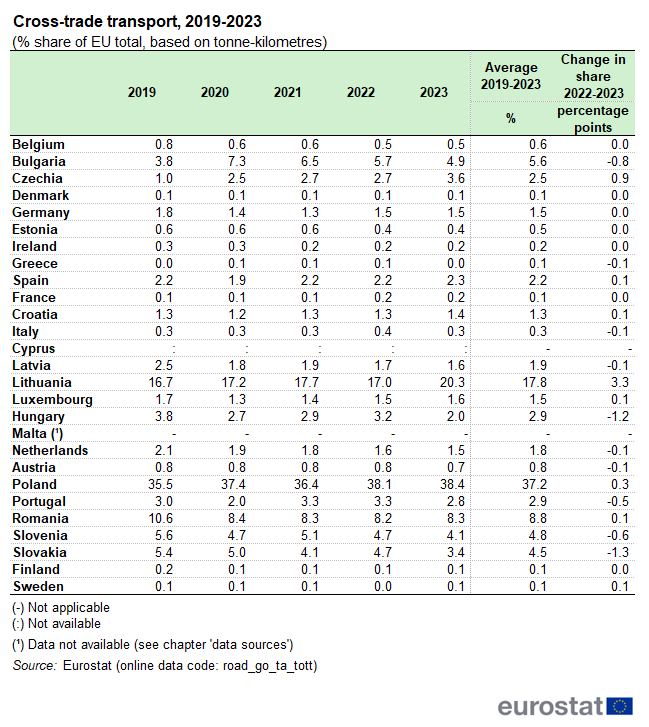
(% share of EU total, based on tonne-kilometres)
Source: Eurostat (road_go_ta_tott)
Road freight transport in tonnage and average loads
EU road freight transport in tonnes registered a negative average annual growth rate of 0.8% over the period 2019-2023 (see Table 5). The highest positive average annual growth rates were observed in Bulgaria (+9.6%), followed by Cyprus (+8.5%) and Romania (+5.8%). Significant negative average annual growth rates over the same period were noted in Greece (-7.3%), Portugal (-4.7%) and Luxembourg (-4.3%).
Between 2022 and 2023, total EU road freight transport decreased by 3.4% in terms of tonnes carried. The transported tonnage increased in 8 EU countries. The largest increases were observed in Lithuania (+19.4%), Cyprus (+5.4%), Bulgaria (+2.9%) and Croatia (+2.1%). In 18 EU countries, the transported tonnage decreased. The strongest falls were registered in Portugal (-10.4%), Czechia (-8.4%) and Luxembourg (-7.8%).
The 'average load' (in tonnes) presented in this article was calculated by dividing annual freight transport performance (in tonne-kilometres) by the corresponding laden distance travelled (vehicle-kilometres, equivalent to kilometres). At country and EU level, this indicator provides information on the average weight in tonnes carried per kilometre of the entire laden distance travelled. The indicator is calculated separately for national, international and total transport. For total transport, national and international tonne-kilometres are added and then divided by the total laden distance travelled.
The EU average load for total transport was 14.3 tonnes in 2023, with average load of 13.4 tonnes for national transport and 15.7 tonnes for international transport (see Figure 5). In 2023, Finland had the highest international average load at 22.0 tonnes, followed by Cyprus (18.5 tonnes), Spain, Greece and France (18.0 tonnes each). Finland also had the highest national average load at 19.9 tonnes, ahead of Latvia (16.0 tonnes), Bulgaria and Italy (15.8 tonnes each). The average load in national transport in Slovenia was 64.2% below the EU average, with only 4.8 tonnes.

(tonnes)
Source: Eurostat (road_go_ta_tott)
Average distance travelled per tonne of load
The average distance over which 1 tonne of goods is carried has been calculated by dividing tonne-kilometres by tonnes for laden journeys only. This indicator provides information on the average distance travelled per tonne in each country and at EU level. The indicator is calculated separately for national, international and total transport. For total transport, national and international tonne-kilometres for laden journeys are added and then divided by the total tonnes transported.
In 2023, the average distance travelled per tonne in total road freight transport in the EU was 141.6 km, whereas it was 95.6 km in national road freight transport; 611.3 km in international transport; 756.4 km in cross-trade transport and 277.9 km in cabotage transport (see Figure 6).
The average distance travelled per tonne for different types of transport in each EU country is generally affected by the size of the country and its involvement in international transport where longer distances are travelled. Among the EU countries, the average distance travelled per tonne for total transport by Lithuanian hauliers were substantially higher than in most other countries, reaching 524.1 km in 2023. This reflects the importance of international transport for the Lithuanian road transport sector. The average distance travelled per tonne for Lithuanian national transport was 90.4 km in 2023, whereas this distance was 900.6 km for international transport; 877.9 km for cross-trade transport; and 449.7 km for cabotage transport. At the other end of the scale, the average distance travelled per tonne by hauliers registered in Cyprus were much lower, with only 25.1 km for total transport in 2023.
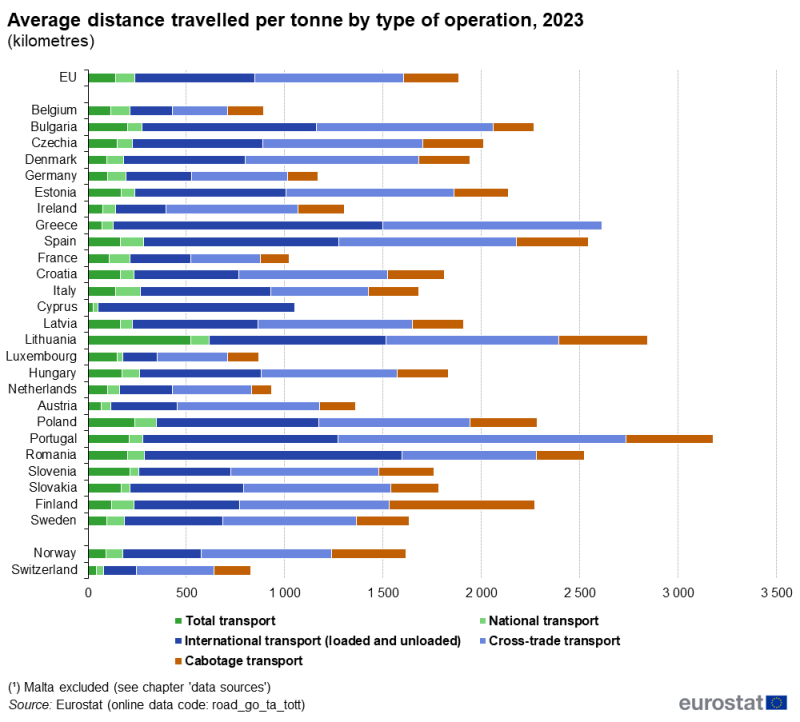
(kilometres)
Source: Eurostat (road_go_ta_tott)
Transport performance by distance class
At EU level, in 2023, most of the total road freight transport performance was carried out over distances between 300 and 999 km (41.0%). This was also the case for most of the EU countries (see Table 6). However, a few countries showed a different pattern with respect to transport performance by distance class. For some islands and countries with an important domestic market, the share of road freight transport over short distances (less than 150 km) was higher: Cyprus, Ireland, the Netherlands and Austria. For Cyprus, 94.1% of transport performance is carried out over distances of less than 150 kilometres. On the other hand, countries where international road transport plays a key role had a higher share of transport performance over long distances; transport over 1 000 kilometres accounted for 40% or more of total tkm in Portugal, Lithuania, Bulgaria and Romania (50.7%, 50.6%, 43.3% and 40.7%, respectively).
The overall trend of a country regarding distances travelled for road freight transport can be assessed based on its figures for the different distance classes. Regarding the distance class of less than 150 km, a notable increase between 2022 and 2023 was recorded in Lithuania (+24.7%). At the other end of the scale, we find Portugal (-14.0%) and Sweden (-9.7%). For the distance class 150-299 km, Lithuania (+23.0%) and Denmark (+9.6%) recorded the highest increases, while Cyprus was at the other end with a decrease of 27.8%, followed by Estonia (-17.8). The distance class 300-999 km showed notable increases in Lithuania (+16.7%) and Denmark (+12.2%). Cyprus, Estonia and Portugal were the countries recording decreases of more than 20% for this distance class (-75.0%, -22.9% and -21.0%, respectively). Lastly, for the distance class of 1 000 km or more, Cyprus, Luxembourg and Lithuania registered the highest increases, with 65.0%, 20.3% and 16.7%, respectively. In contrast, Belgium, Hungary and Slovakia recorded the highest decreases for this distance class, with 30.8%, 29.7% and 22.2%, respectively.
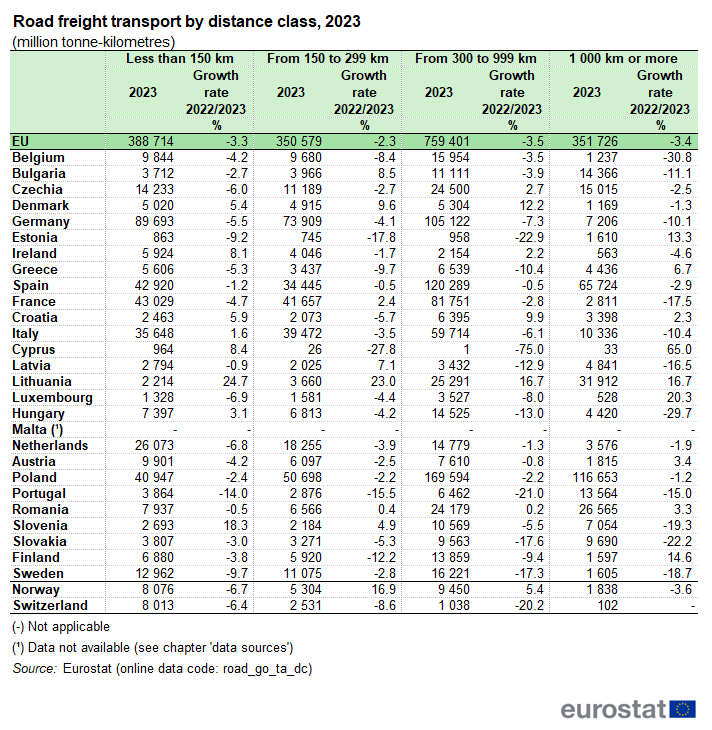
(million tonne-kilometres)
Source: Eurostat (road_go_ta_dc)
Empty runnings of road freight vehicles
Figure 7 shows the percentage of vehicle-kilometres recorded for empty runnings in 2023. At EU level, one fifth of total road freight vehicle-kilometres were carried out by empty vehicles (21.8%). The share of vehicle-kilometres travelled by empty vehicles is somewhat higher for national transport than for the total, at around one quarter (25.9%). In international road transport, the share of empty vehicle-kilometres was 13.1%.
For total road freight transport, in 2023 a total of 17 EU countries recorded a share of vehicle-kilometres by empty vehicles between 15% and 30%. The share for Cyprus was considerably higher, at 42.3%, which likely indicates that a big share of the road freight performance is linked either to goods imported through ports or construction traffic, both of which are linked to empty journeys in one of the two directions. Road freight performance by empty vehicles was also well above the EU average for Ireland (36.9%), Austria (34.0%) and Greece (32.0%). At the other extreme were Denmark, with only 7.5% vehicle-kilometres by empty vehicles, and Lithuania with 10.5%.
Empty vehicles accounted for a large share of vehicle-kilometres in national transport for almost all countries. In contrast, for international transport, all EU countries reported lower levels of empty running compared with national transport, except Belgium, France and Sweden. Only a few countries recorded shares of more than 20% of vehicle-kilometres by empty vehicles in international transport in 2023: Ireland (24.2%), Austria (23.1%), Luxembourg (21.7%), France (21.0%), Sweden (20.3%) and Germany (20.1%). There is certainly an economic importance of being able to acquire loads for return journeys in international transport.

(% share in vehicle-kilometres)
Source: Eurostat (road_go_ta_tott)
Source data for tables and graphs
Context
Data presented in this publication were collected in the framework of Regulation (EU) No 70/2012 on statistical returns in respect of the carriage of goods by road (recast). These data are based on sample surveys carried out in the reporting countries, i.e., the EU countries, Norway and Switzerland, and record the road goods transport undertaken by vehicles registered in these countries.
Reporting countries use their own national surveys for the collection of data based on returns from road hauliers. The results are microdata referring to vehicles and their linked journeys providing detailed information on goods transported. At European level, common aggregation procedures have been used that might diverge from national practices. Therefore, differences might occur between the figures in this publication and national values.
Country specific notes
Bulgaria and Romania: While Bulgaria and Romania had no obligation prior to accession in 2007, they started reporting data for the reference year 2006.
Croatia: While Croatia had no obligation prior to accession in 2013, it started reporting data from reference year 2008.
Malta: Regulation (EU) No 70/2012 does not apply to Malta, as long as the number of Maltese-registered goods road transport vehicles licensed to engage in international transport does not exceed 400 vehicles.
Finland: National and international surveys have been harmonised and follow a common methodology from Q1 2011 onwards, leading to a break in series in 2011.
Sweden: A break in series occurred in 2014 following a change in methodology. On the basis of a specific survey, Sweden corrected the European road freight survey results for trucks participating in the sample which were not in use over the surveyed period.
Methodological notes
EU totals calculated in this publication refer to road freight transport reported by the 27 EU countries excluding Malta which does not report road freight transport statistics.
International transport loaded and unloaded: International transport as presented in this publication is based on goods loaded and unloaded in the reporting EU countries. Double counting is avoided since reporting relates only to resident carriers of the reporting countries: the figures sum up the goods transported by resident carriers to all other countries of the world and the goods brought into the reporting country by resident carriers from all other countries of the world.
Road freight transport performance in tonne-kilometres derives only from loaded journeys. Distances travelled by empty vehicles are not considered.
Direct access to
- Transport, see:
- Road transport (t_road)
- Transport, see:
- Road transport (road)
- Road freight transport measurement (road_go)
- Key figures on European transport — 2023 edition - Key figures
- Eurostat regional yearbook — 2023 edition - Flagship publications
- Key figures on Europe – 2023 edition - Key figures
- Road freight transport measurement (ESMS metadata file)
- Glossary for transport statistics — 5th edition — 2019 — Manuals and guidelines
- Methodologies used in road freight transport surveys in Member States, EFTA and 3 candidate countries — 2023 edition - Manuals and guidelines
- Road freight transport methodology — Revised edition, August 2017 - Manuals and guidelines
- Regulation (EC) No 70/2012 on statistical returns in respect of the carriage of goods by road (recast)
- Regulation (EU) No 1304/2007 of 7 November 2007 amending Directive 95/64, Regulation (EC) No 1172/98, Regulations (EC) No 91/2003 and (EC) No 1365/2006 with respect to the establishment of NST 2007 as the unique classification for transported goods in certain transport modes
- Commission Regulation (EC) No 202/2010 amending Regulation (EC) No 6/2003 concerning the dissemination of statistics on the carriage of goods by road
